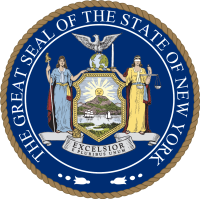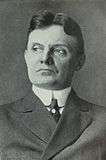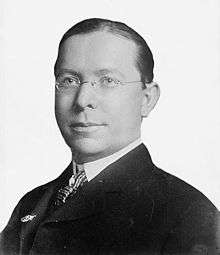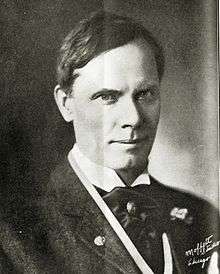1914 New York state election
The 1914 New York state election was held on November 3, 1914, to elect the Governor, the Lieutenant Governor, the Secretary of State, the State Comptroller, the Attorney General, the State Treasurer, the State Engineer, a U.S. Senator and a judge[1] of the New York Court of Appeals, as well as all members of the New York State Assembly and the New York State Senate, and delegates-at-large to the New York State Constitutional Convention of 1915.
| |||||||||||||||||||||||||
| |||||||||||||||||||||||||
| |||||||||||||||||||||||||
| Elections in New York State | ||||||||||||
|---|---|---|---|---|---|---|---|---|---|---|---|---|
 | ||||||||||||
|
||||||||||||
|
|
||||||||||||
|
||||||||||||
History
This was the first time that U.S. Senators from New York were elected by general ballot. Until 1911, the U.S. Senators had been elected by the New York State Legislature, but the lengthy stalemate between Tammany and a faction led by State Senator Franklin D. Roosevelt, who was decided to impede the election of William F. Sheehan or any other crony of Tammany boss Charles F. Murphy, led to a constitutional amendment. Since 1914, the U.S. Senators have been elected with the state officers on the state ticket, and selected in the party primaries.
The Socialist state convention met on July 5 at Rochester, New York. They nominated Charles Edward Russell for U.S. Senator; Gustave Adolph Strebel for governor; Stephen J. Mahoney, of Buffalo, for lieutenant governor; Mrs. Florence C. Kitchelt, of Rochester, for secretary of state; Charles W. Noonan, of Schenectady, for comptroller; James C. Sheehan, of Albany, for treasurer; Frederick O. Haller, of Buffalo, for attorney general; Prof. Vladimir Karapetoff, of Cornell University, for state engineer; and Louis B. Boudin for the Court of Appeals.[2]
The Prohibition State Committee met on August 15 at Syracuse, New York, and voted to nominate Ex-Governor William Sulzer for governor instead of the previously selected Charles E. Welch, who then ran for lieutenant governor.[3]
This was the first state election at which the parties with "party status" - at this time, the Democratic, Republican and Progressive parties - were required to hold primary elections to nominate candidates for state offices. The primaries were held on September 28.[4]
Republican primary
| Office | ||||||
|---|---|---|---|---|---|---|
| Governor | Charles S. Whitman | 120,073 | Harvey D. Hinman | 61,952 | Job E. Hedges | 43,012 |
| Lieutenant Governor | Edward Schoeneck | 78,563 | Seth G. Heacock | 68,303 | Frank A. Sidway | 57,348 |
| Secretary of State | Francis M. Hugo | 71,037 | William D. Cunningham[5] | 67,050 | Eugene H. Porter[6] | 58,845 |
| Comptroller | Eugene M. Travis | 88,765 | James Hooker | 62,414 | Samuel Strasburger | 48,519 |
| Attorney General | Egburt E. Woodbury | 124,009 | Edward R. O'Malley | 72,467 | ||
| Treasurer | James L. Wells | 184,043 | ||||
| State Engineer | Frank M. Williams | 159,243 | Arthur O'Brien | 36,892 | ||
| Judge of the Court of Appeals | Emory A. Chase | 180,394 | ||||
| U.S. Senator | James W. Wadsworth, Jr. | 89,960 | William M. Calder | 82,895 | David Jayne Hill | 37,102 |
Democratic primary
| Office | ||||||
|---|---|---|---|---|---|---|
| Governor | Martin H. Glynn | 175,772 | John A. Hennessy | 68,387 | ||
| Lieutenant Governor | Thomas B. Lockwood | 158,159 | William Gorham Rice | 57,305 | ||
| Secretary of State | Mitchell May | 167,198 | Sidney Newborg | 43,251 | ||
| Comptroller | William Sohmer | 158,309 | George G. Davidson, Jr. | 58,077 | ||
| Attorney General | James A. Parsons | 151,122 | John Larkin | 57,096 | ||
| Treasurer | Albert C. Carp | 147,443 | Charles E. Sunderlin | 55,055 | ||
| State Engineer | John A. Bensel | 146,533 | Raleigh Bennett | 58,485 | ||
| Judge of the Court of Appeals | Samuel Seabury | 139,694 | John N. Carlisle | 65,820 | ||
| U.S. Senator | James W. Gerard | 138,815 | Franklin D. Roosevelt | 63,879 | James F. McDonough | 17,862 |
Progressive primary
| Office | ||||
|---|---|---|---|---|
| Governor | Frederick M. Davenport | 18,643 | William Sulzer | 14,366 |
The other Progressive candidates were nominated unopposed.
The Socialist Labor ticket was filed with the Secretary of State on October 9, 1914.[7] They nominated a full ticket.[8]
Ex-Governor Sulzer's aim was to defeat Glynn whom he considered a back-stabber. For this purpose he organized the American Party, and accepted the nomination by the Prohibition Party. He also sought the nomination of the Progressive Party, but was defeated in their primary. The American Party Executive Committee also endorsed a full slate (Prohibitionists Welch and Clements; Progressives Call and Colby; Democrat Seabury; Charles Horowitz for comptroller; Charles Podsenick for attorney general; and Robert Butler for State Engineer) for the other offices, but did not file a petition to nominate them, so they did not appear on the ballot in the American column.[9]
Result
Almost the whole Republican ticket was elected; only Justice Seabury managed to defeat the Republican candidate Emory A. Chase.
The incumbents Glynn, May, Sohmer, Parsons, Call and Bensel were defeated.
The Republican, Democratic, Independence League, Progressive, Socialist and Prohibition parties maintained automatic ballot access (necessary 10,000 votes for governor), the American Party attained it, and the Socialist Labor Party did not re-attain it.
34 Republicans and 17 Democrats were elected to a two-year term (1915–16) in the New York State Senate.
100 Republicans, 49 Democrats and one Progressive[10] were elected for the session of 1915 to the New York State Assembly.
| Office | Republican ticket | Democratic ticket | Independence League ticket | American ticket | Prohibition ticket | Progressive ticket | Socialist ticket | Social Labor[11] ticket | ||||||||
|---|---|---|---|---|---|---|---|---|---|---|---|---|---|---|---|---|
| Governor | Charles S. Whitman | 686,701 | Martin H. Glynn | 412,253 | Martin H. Glynn | 125,252 | William Sulzer | 70,655 | William Sulzer | 54,189 | Frederick M. Davenport | 45,686 | Gustave Adolph Strebel | 37,793 | James T. Hunter[12] | 2,350 |
| Lieutenant Governor | Edward Schoeneck | 622,493 | Thomas B. Lockwood[13] | 534,660 | Edward Schoeneck | (none) | Charles E. Welch[14] | 44,484 | Chauncey J. Hamlin | 113,385 | Stephen J. Mahoney[15] | 51,304 | Jeremiah D. Crowley[16] | 3,566 | ||
| Secretary of State | Francis M. Hugo | 601,857 | Mitchell May | 561,429 | Mitchell May | (none) | John R. Clements | 68,049 | Sydney W. Stern | 72,371 | Florence Cross Kitchelt | 52,970 | Edmund Moonelis[17] | 3,490 | ||
| Comptroller | Eugene M. Travis | 657,373 | William Sohmer | 553,254 | William Sohmer | (none) | Neil D. Cranmer[18] | 29,373 | John B. Burnham | 68,111 | Charles W. Noonan[19] | 51,845 | Charles E. Berns | 3,579 | ||
| Attorney General | Egburt E. Woodbury | 651,869 | James A. Parsons | 529,045 | Edward R. O'Malley | 12,132 | (none) | Walter T. Bliss[20] | 27,949 | Robert H. Elder[21] | 77,945 | Frederick O. Haller | 52,808 | John Hall[22] | 3,711 | |
| Treasurer | James L. Wells | 622,811 | Albert C. Carp | 526,025 | Homer D. Call | (none) | Edward A. Packer | 29,071 | Homer D. Call | 117,628 | James C. Sheehan | 54,202 | Anthony Houtenbrink[23] | 3,561 | ||
| State Engineer | Frank M. Williams | 677,393 | John A. Bensel | 509,944 | John Martin | 9,686 | (none) | James Adamson | 27,723 | Lloyd Collis | 68,110 | Vladimir Karapetoff | 51,980 | August Gillhaus | 3,676 | |
| Judge of the Court of Appeals | Emory A. Chase | 594,414 | Samuel Seabury | 650,468 | Samuel Seabury | (none) | Coleridge A. Hart[24] | 28,337 | Samuel Seabury | Louis B. Boudin | 52,225 | Edmund Seidel | 5,054 | |||
| U.S. Senator | James W. Wadsworth, Jr. | 639,112 | James W. Gerard | 571,419 | James W. Gerard | (none) | Francis E. Baldwin[25] | 27,813 | Bainbridge Colby | 61,977 | Charles Edward Russell | 55,266 | Erwin A. Archer | 3064 | ||
Obs.:
- The vote for governor defines the ballot access.
- Numbers are total votes on all tickets for candidates who ran on more than one ticket, except for governor.
- Glynn also polled 3,764 votes; and Sulzer 1,426; in the "no-party column," a blank space provided for write-in candidates.
Notes
- to fill the vacancy caused by the election of Willard Bartlett as Chief Judge
- C. E. RUSSELL FOR SENATOR in NYT on July 6, 1914
- SULZER HEADS DRY TICKET in NYT on August 16, 1914
- RESULTS OF PRIMARIES in NYT on September 29, 1914
- William D. Cunningham, of Ulster County, ran for comptroller in 1912
- Dr. Eugene H. Porter, State Commissioner of Health
- SOCIALIST LABOR TICKET in NYT on October 10, 1914
- SILVERSMITH FOR GOVERNOR in NYT on October 25, 1914
- SULZER DOMINATES HIS AMERICAN PARTY in NYT on October 25, 1914
- The Progressive member was Hamilton Fish III who had run also on the Democratic ticket in his district.
- The election law limited the name of any party on the ballot to eleven letters, so that the "Socialist Labor" had to be shortened to "Social Labor"
- James T. Hunter (1870-1952), silversmith, ran also for Mayor of New York City in 1903, and for lieutenant governor in 1910 Obit in NYT on January 7, 1952 (subscription required)
- Thomas B. Lockwood, son of Daniel N. Lockwood
- Charles E. Welch, grape juice manufacturer, of Westfield, ran also for governor in 1916
- Stephen J. Mahoney, ran also in 1916
- Jeremiah D. Crowley, of Marcellus, ran also for state engineer in 1910, and for lieutenant governor in 1912
- Edmund Moonelis, ran also in 1912
- Neil Dow Cranmer, of Elmira, ran also for comptroller in 1914 and 1926; for secretary of state in 1916; and for Congress at-large in 1940
- Charles W. Noonan, of Schenectady, Alderman from Schenectady's 7th Ward, ran also for comptroller in 1914, 1916 and 1926; for treasurer in 1918; for secretary of state in 1920; for lieutenant governor in 1932; and for Congress at-large in 1934
- Walter T. Bliss, ran also for the Court of Appeals in 1917
- Robert H. Elder, ran also in 1916
- John Hall, ran also for attorney general in 1908, and Governor in 1912
- Anthony Houtenbrink, ran also for comptroller in 1916
- Coleridge Allen Hart (b. July 11, 1852 Peekskill), lawyer, of Brooklyn, ran also for attorney general in 1889; for the Court of Appeals in 1907, 1908, 1914, 1916, 1917 and 1920; and for the U.S. Senate in 1922
- Francis E. Baldwin (1859-1930), of Elmira, financier, ran also for governor in 1894; for chief judge in 1897; for attorney general in 1910 and 1922; and for the Court of Appeals in 1920, F.E. BALDWIN IS DEAD; ELMIRA (N.Y.) FINANCIER in NYT on December 23, 1930 (subscription required)
Sources
- Petitions for tickets: PETITIONS FILED IN ALBANY in NYT on September 9, 1914
- The primary ballots: HENNESSY'S NAME LEADS in NYT on September 15, 1914
- Result (parcial) of Primaries: VOTE FOR GOVERNOR AND SENATOR in NYT on September 29, 1914
- The tickets, and sketches of candidates for Governor and Senator: FULL TICKETS OF THE PARTIES in NYT on October 25, 1914
- Result (final) of Primaries: PRIMARY CALLED OUT HALF STATE VOTE in NYT on October 9, 1914
- Result: WHITMAN WON BY 145,432 in NYT on December 5, 1914
Vote totals from New York Red Book 1915


